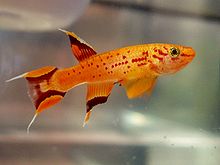Aphyosemion australe
| Aphyosemion australe | |
|---|---|

| |
| Golden variety of Aphyosemion australe Male | |
| Scientific classification | |
| Domain: | Eukaryota |
| Kingdom: | Animalia |
| Phylum: | Chordata |
| Class: | Actinopterygii |
| Order: | Cyprinodontiformes |
| Family: | Nothobranchiidae |
| Genus: | Aphyosemion |
| Species: | A. australe
|
| Binomial name | |
| Aphyosemion australe (Rachow, 1921)
| |
| Synonyms[2] | |
Aphyosemion australe, the lyretail panchax, golden panchax or Cape Lopez lyretail, is a species of freshwater fish belonging to the family Aplocheilidae. It is found around Cape Lopez and in surrounding areas in Gabon.[2]
Appearance
A. australe comes in a two colours. The wild type are brown and called 'chocolate' in the aquarium hobby and a man made 'gold' form exists which is orange; this form was spontaneous mutation bred by a Finnish aquarist name Hjerssen in 1952. JJ Scheel in "Rivulins of the World World (TFH PRess, 1970) deleted the pointed out these were not a separate specues and deprecated the name Aphyosemion australe hjersseni. Males can reach a length of around 6 cm, with females being slightly smaller. The caudal fin is lyre-shaped, which is characteristic of the genus. The females also are less colourful; their body colouration is brownish tan for the wild form and a light tan for the gold/orange form, and they have rounder fins.[3]
In the aquarium
The Cape Lopez lyretail is one of the most popular and commonly available species of killifish. Spawns readily in the aquarium in nearly any water, spawning in fine-leafed water plants, such as aquatic moss. The fry emerge after 14 days at a preferred temperature of 26 °C (79 °F). They adapt well to any variety of commercially prepared foods, flake or frozen livefoods but like all killifish do better with living foods cultured or caught from clean sources.[citation needed]
References
- ^ Moelants, T. (2010). "Aphyosemion australe". IUCN Red List of Threatened Species. 2010: e.T181981A7778618. doi:10.2305/IUCN.UK.2010-3.RLTS.T181981A7778618.en.
- ^ a b Froese, Rainer; Pauly, Daniel (eds.) (2013). "Aphyosemion australe" in FishBase. August 2013 version.
- ^ Puddlefish. "Care And Breeding Of Aphyosemion Australe". Retrieved 2018-02-21.

